The first shots of the Second World War were fired by a battleship. The German pre-dreadnought Schleswig-Holstein signaled the start of the German assault on the Polish supply depot of Westerplatte by opening fire. Commandoes carried aboard the ship attempted to assault the base, but were repulsed, and the Poles held out for a full week in the face of heavy German attacks, including bombardment from Schleswig-Holstein.
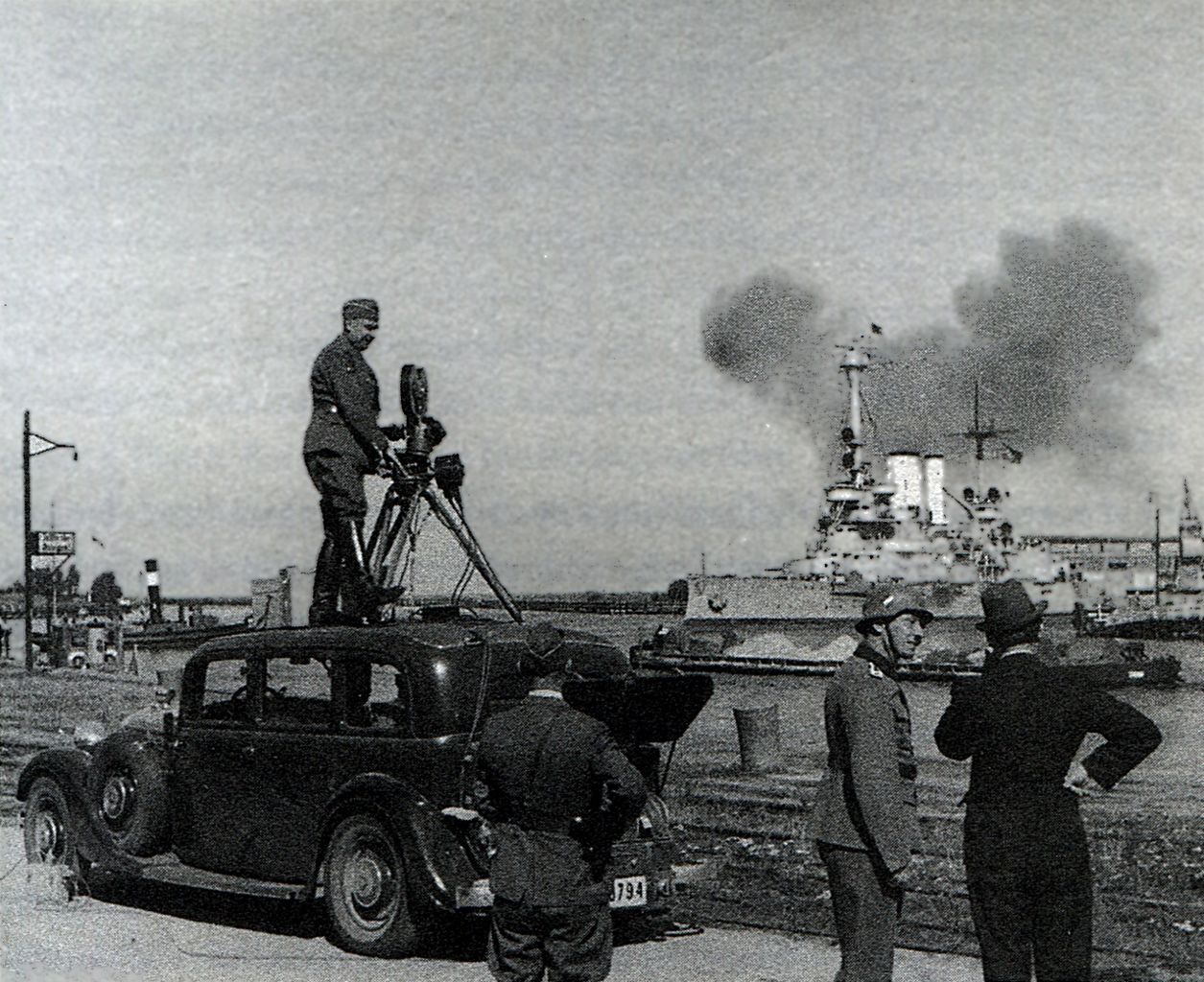
A camera crew filming Schleswig-Holstein's bombardment of Westerplatte
A total of six German battleships served during WWII, the most diverse mix of ships of any of the major powers.1 Two, Schleswig-Holstein and Schlesien, were veterans of Jutland, built to designs pre-dating Dreadnought. The next pair, Scharnhorst and Gneisenau, were among the handful of interwar capital ships that didn't approach the 35,000 ton limit of the Washington Naval Treaty. Armed with 3 triple 11" turrets, they were designed to fight the French Dunkerque class, and proved quite effective during the war. Bismarck is probably the most famous battleship in history2 and her sister Tirpitz is also well-known. Possibly the most powerful battleships ever completed in Europe, mostly due to their designer's blatant disregard for treaty limits, these were essentially modernized versions of the WWI Bayern class, with 4 twin 15" turrets, a speed of about 30 kts, and an armor scheme of WWI vintage, instead of the all-or-nothing schemes used in the allied treaty battleships.
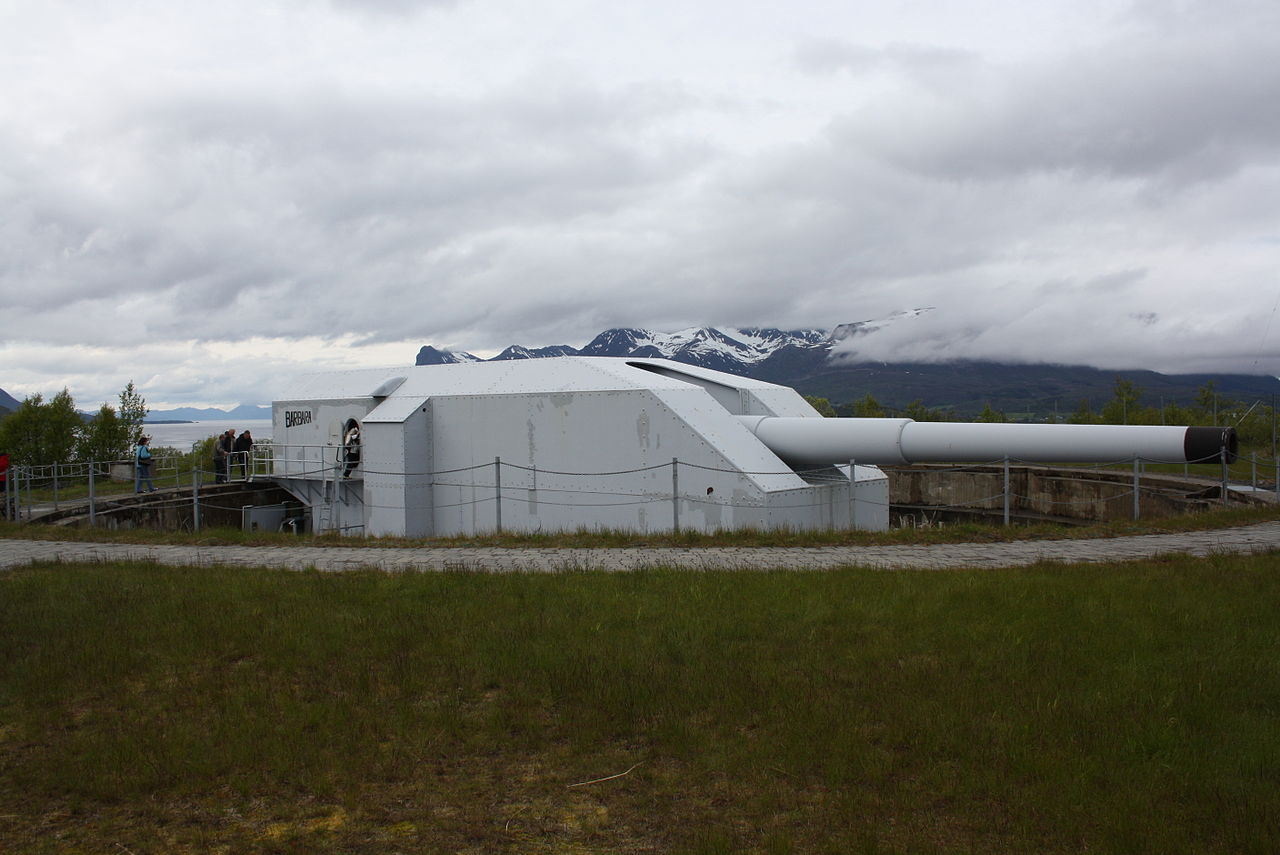
16" gun intended for the H-class, mounted at Trondenes Fort, Norway
Nor was Hitler satisfied with this fleet. He planned an additional six ships of the H class,3 initially an enlarged version of the Bismarcks with 16" guns. The keels of the first two were laid down shortly before the outbreak of war, and all six were suspended in 1939. As the war went on, the design was revised numerous times to take into account the lessons of the war, and Hitler's growing megalomania. While the 1939 design had been intended to displace 56,000 tons, roughly the size of the Iowas, the final 1944 version (H44) was over twice that.4
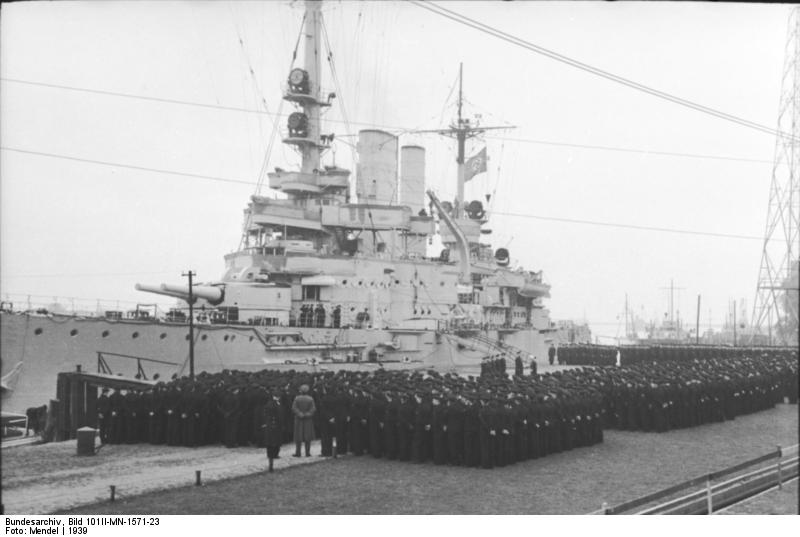
Schlesien in 1939
The Germans used their battleships rather differently from the Americans and British. They had no carriers to screen, and never attempted to contest the sea with their surface fleet for more than short periods. The modern ships spent the majority of their careers either raiding commerce or threatening to do so. While this was not entirely useless, it probably didn't justify the investment made in the ships. The pre-dreadnoughts spent most of the war in training service, occasionally being used to provide support to operations in the Baltic.

Gneisenau very early in her career5
Bismarck and Tirpitz were still under construction at the outbreak of the war, but Scharnhorst and Gneisenau were in action from the start. They made a couple of sweeps into the North Sea, most notably sinking the armed merchant cruiser Rawalpindi off the Faroe Islands in November of 1941. They first saw serious combat during the invasion of Norway. On April 9th, 1940, the ships encountered the battlecruiser Renown. Gneisenau landed a pair of hits on Renown, lightly damaging her, while the British ship struck back with a more damaging set of hits, before the action was broken off due to fear of a British destroyer attack. Both ships returned to port to repair the damage they'd suffered.
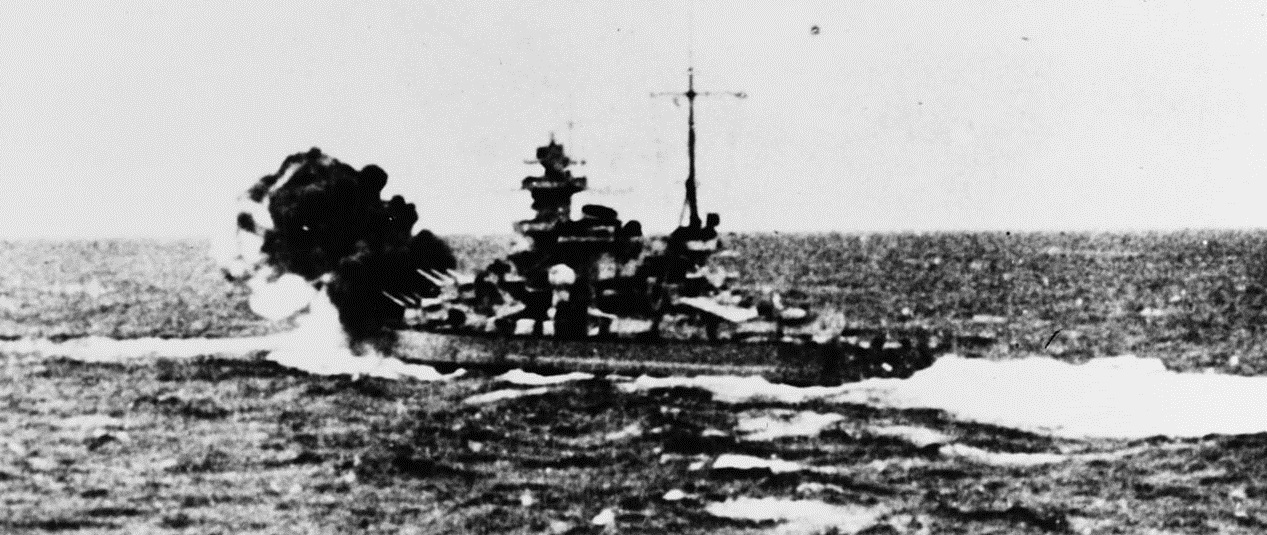
Scharnhorst firing on Glorious
In early June, they sortied again, this time to interfere with the allied evacuation of Narvik in northern Norway.6 There, the German ships had an incredible stroke of luck, catching the aircraft carrier Glorious unprepared for action. She had no airplanes airborne, only two-thirds of her boilers hot, and an escort of only two destroyers. All three British ships were swiftly dispatched, although one of the destroyers managed to torpedo Scharnhorst, doing substantial damage. A few weeks later, as Gneisenau returned to Germany, she was also torpedoed, this time by a British submarine.
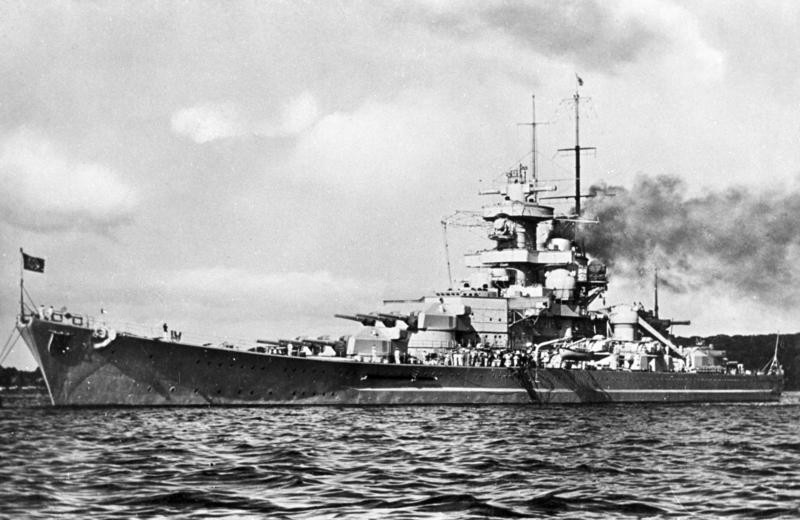
Gneisenau with the revised bow
The damage put both ships out of action until the beginning of 1941, when they sortied into the Atlantic, intending to attack convoys. The effort was less than a total success, as the two ships sank only 22 merchantmen over the course of the 60-day cruise. They did manage to carry out their orders to avoid action with British capital ships, despite encountering three battleships protecting various convoys. The two ships finally reached Brest, on the French coast, in March. There, they were subject to intense air attack, the resulting damage preventing both of them from participating in the next German battleship action.
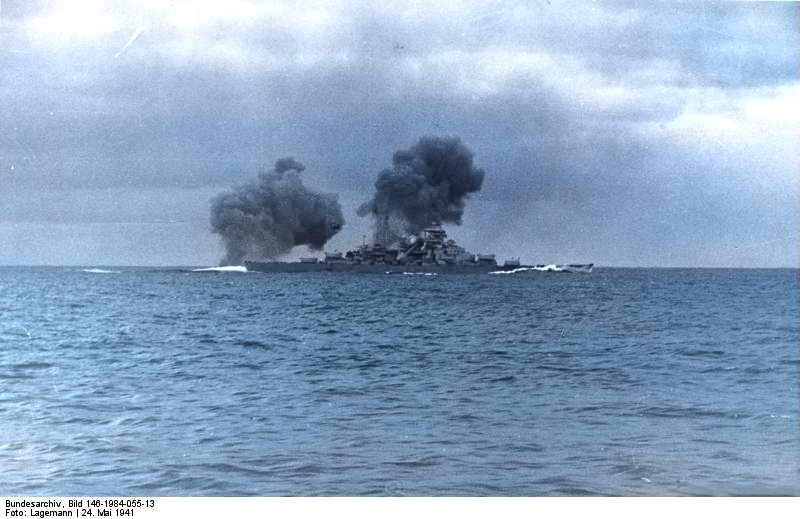
Bismarck firing on Prince of Wales at Denmark Strait
By May of 1941, the Bismarck was finally ready, and it was decided to send her into the Atlantic in another effort to disrupt the vital Atlantic convoys. Bismarck, accompanied by the heavy cruiser Prince Eugen, sortied through the Denmark Strait, between Iceland and Greenland, but were detected by patrolling British cruisers, who called for help. The battlecruiser Hood, long the pride of the British fleet, and the new battleship Prince of Wales, still with yard workers aboard, responded. Within 8 minutes of the battle being opened, Bismarck managed to land a hit on one of Hood's magazines, leaving only three survivors. Prince of Wales fought on, hindered by teething problems with her turrets, and inflicted three hits on Bismarck. One flooded a generator room, while another caused flooding in the bow and rendered 1,000 tons of fuel oil unusable.
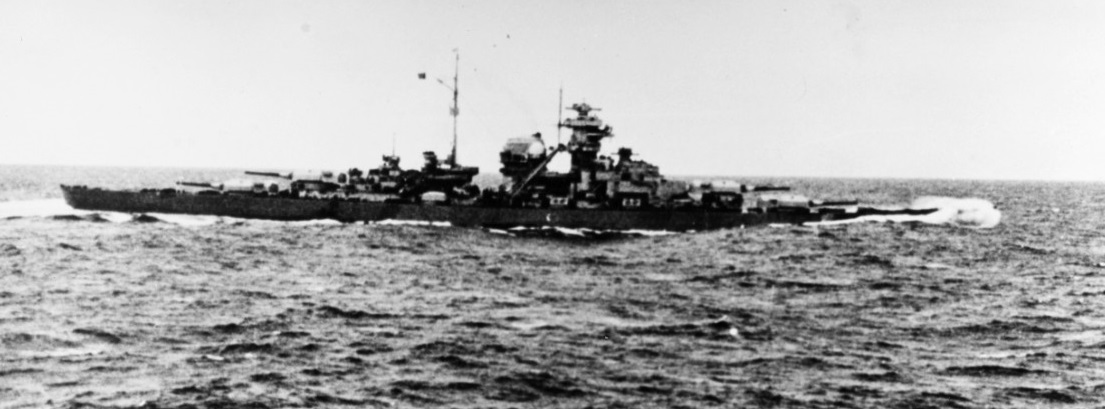
Bismarck shortly after Denmark Strait, before she and Prince Eugen separated
Bismarck covered Prince Eugen's break for the open sea, then turned for France. The British lost contact, and Bismarck almost slipped away from them, before a triangulated radio transmission allowed them to find her again. A carrier strike took out the German ship's rudder, and allowed the British to catch up.
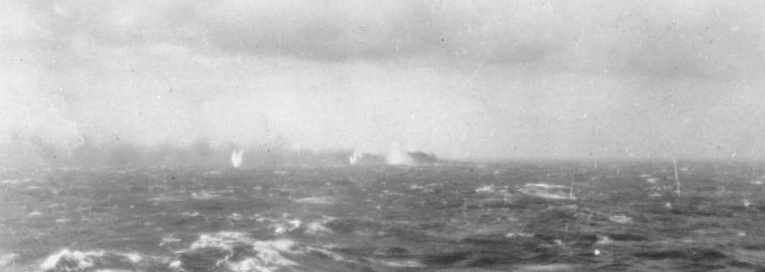
Bismarck burning during her final battle
On May 27th, the battleships Rodney and King George V appeared over the horizon. They pounded Bismarck, reducing her to a floating wreck in half an hour. Bismarck was unable to fight back effectively,7 and the British sank her after less than two hours.8 Only 116 of the 2,200-man crew survived, as the U-boat threat prevented the British from lingering to perform rescue operations.
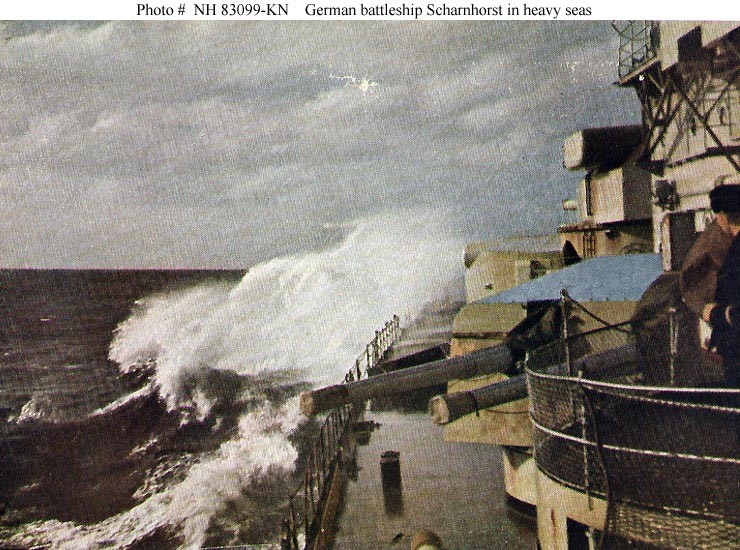
Scharnhorst at sea
All was quiet for the German capital ships until early 1942. The British air attacks on the ships in France were growing more and more determined, and it was decided to move them back to Germany, at least partially to counter the attack on Norway that Hitler believed was coming. While the obvious route was to head back the way they had come, around Scotland and into the North Sea, Hitler instead decided to send them through the English Channel, counting on surprise and the Luftwaffe to protect the ships. On the night of February 11th, Scharnhorst and Gneisenau, accompanied by Prince Eugen, sortied from Brest. It was almost 12 hours before they were detected, and subsequent coordination problems allowed all three ships to slip through the Straits of Dover undamaged. However, both battleships fell victim to mines in the North Sea, forcing them into drydock for repair.

Gneisenau after being bombed
It took Scharnhorst a year to return to service, while Gneisenau never emerged from the yard. A few weeks after the Channel Dash, she was fully repaired and being readied for deployment to Norway. Part of this preparation was loading of her ammo, which for some reason was carried out while she was still in the drydock.9 A British bombing raid caught her in this state, and ignited much of the propellant in the forward turret, whose magazine couldn't be flooded because she was in drydock. The resulting explosion damaged the ship badly enough that she never went to sea again.

Tirpitz
Tirpitz was finally ready for action at this point, and sortied to Norway, where she would spend her entire career. There, she threatened the Arctic convoy lifeline to Russia. She never came close to an actual convoy, and only fired her main guns in anger once, bombarding Svalbard in September 1943 in company with Scharnhorst,10 but she had an outsize impact on the course of the war in the north. Most notably, the British ordered convoy PQ17 to scatter because they believed she was about to attack, leading to the near-annihilation of the convoy's ships. There was also the drain on British resources, as many warships were required to cover the convoys against the possibility of a sortie.
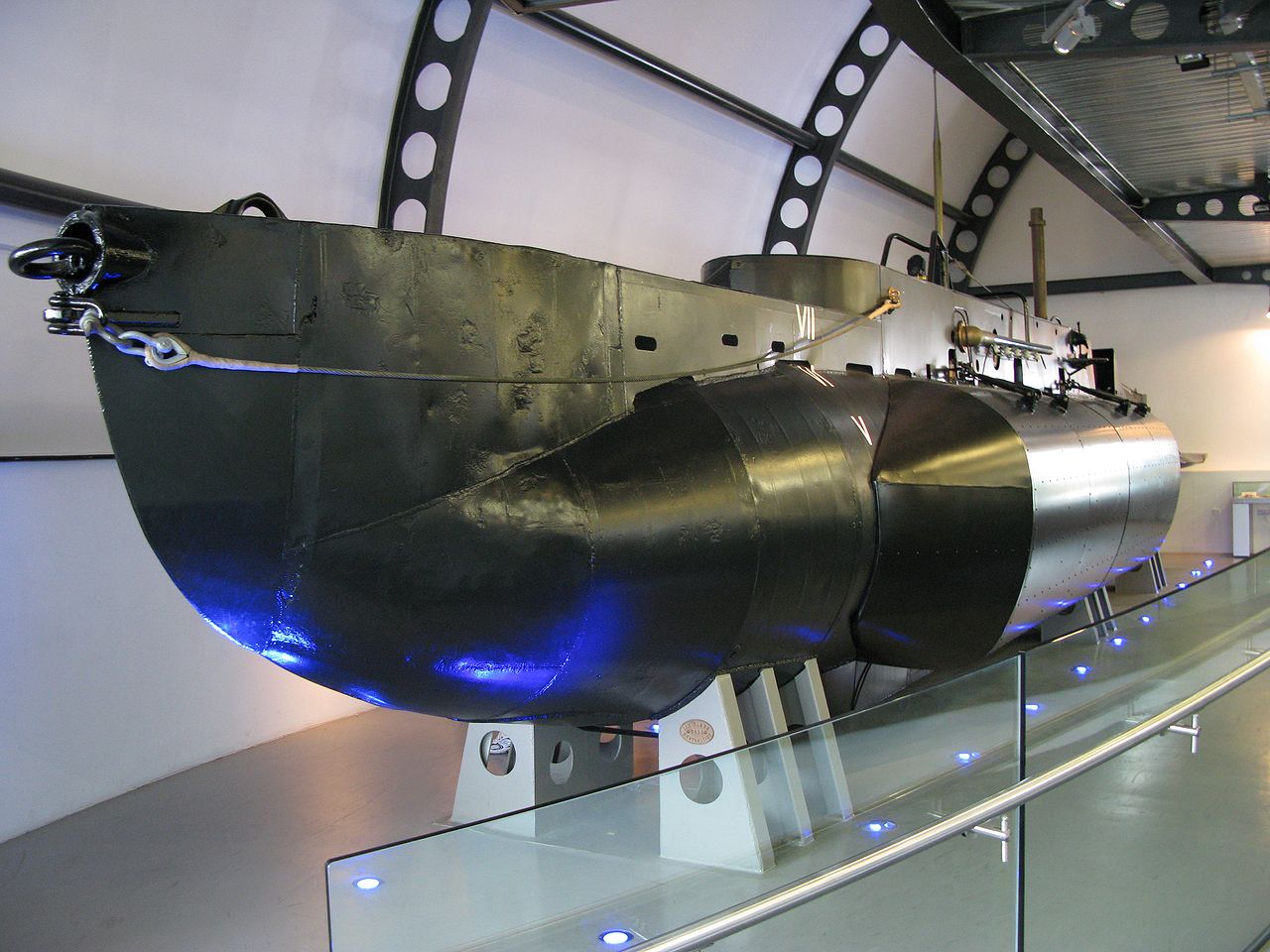
A midget submarine of the same type used against Tirpitz
Unfortunately, the lack of fuel and Hitler's orders to avoid risking the ship kept Tirpitz safely in the fjords, where narrow walls and heavy AA fire made conventional bombing ineffective. The first success came from a midget submarine attack in September of 1943 which disabled Tirpitz for six months.
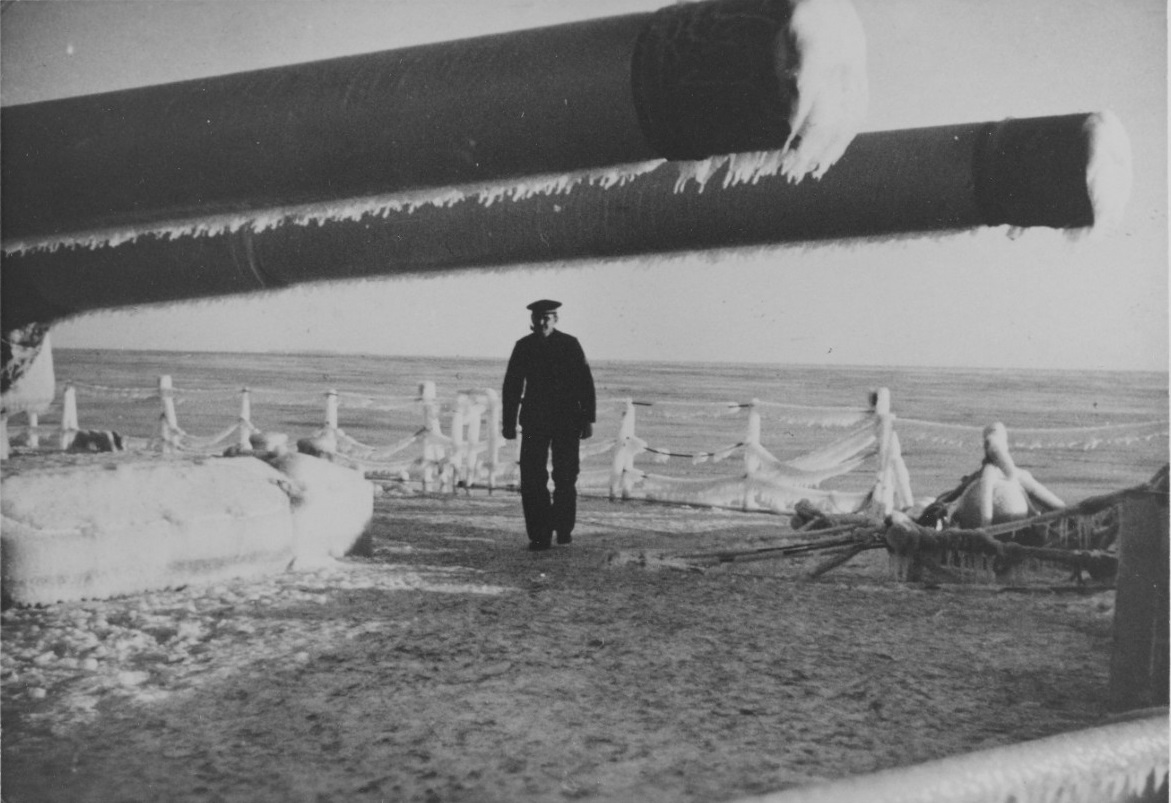
Ice on the deck and guns of Scharnhorst
Scharnhorst had joined her in Norway early that year, and was the primary threat to the convoys after submarine attack. In December, she sortied against Convoy JW 55B. The convoy's escorting cruisers used their superior radar to hold her off until the distant escort, led by the battleship Duke of York, arrived. The British battleship quickly gained the upper hand, hitting Scharnhorst at least thirteen times in exchange for a single graze, which temporarily disabled her radar. The German battleship, battered and limping, soon succumbed to torpedo attack. Only 36 men of the 1,968 aboard were rescued from the freezing water.
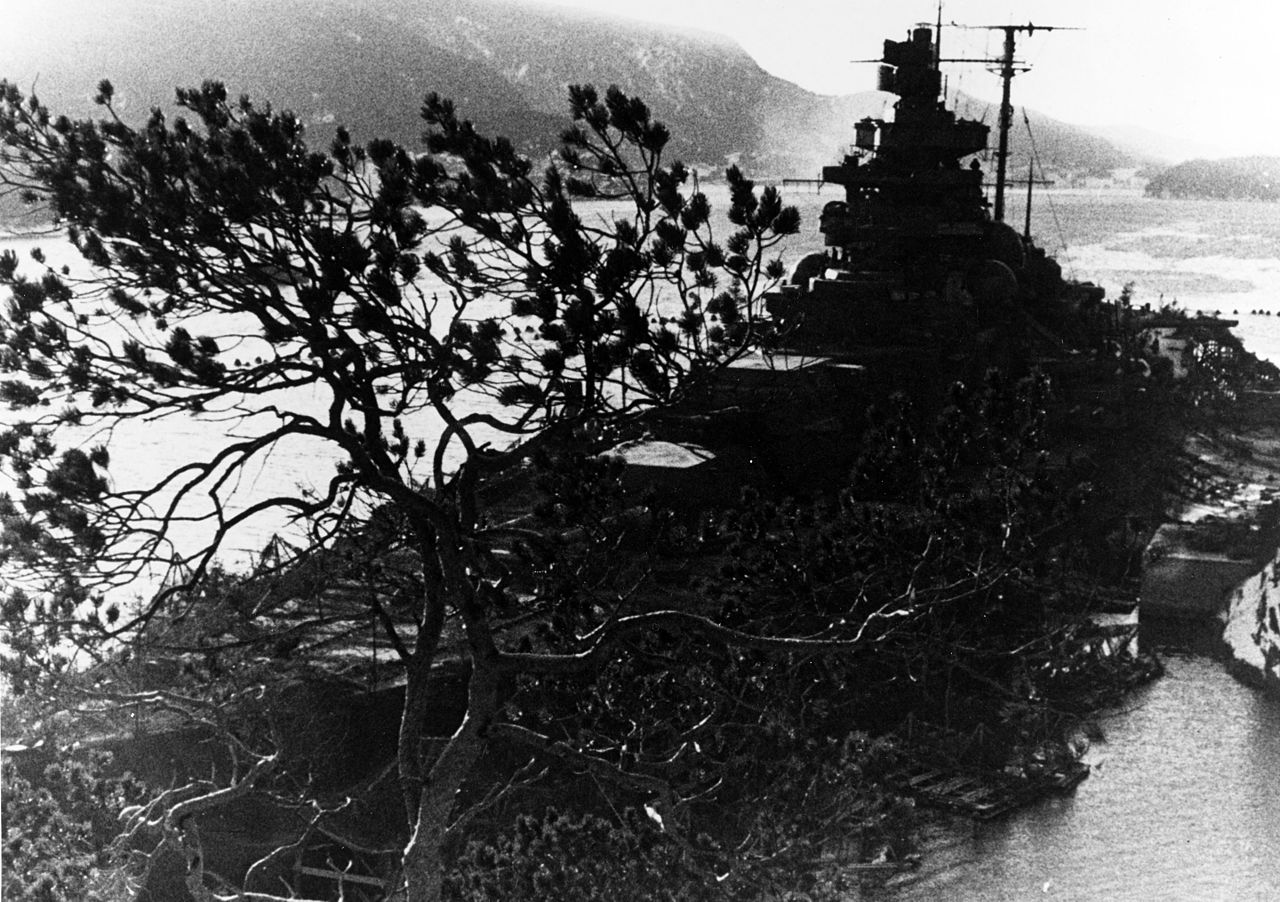
Tirptiz camouflaged in a fjord
Just as the Tirpitz was about to return to service in April 1944, British dive-bombers damaged the ship enough to force her to spend another two months in the "yard".11 The summer of 1944 saw more carrier raids, which did little damage due to the battleship's thick armor. Finally, the job of destroying the ship was turned over to the RAF, who attacked in September with the famous Tallboy bomb, damaging Tirpitz more badly than any previous attack. It was decided to convert her into a floating battery, to resist the allied invasion of Norway that Hitler insisted was coming. A second attack proved relatively ineffective, but the third scored two direct hits with the 12,000 lb bombs, capsizing the ship in minutes.
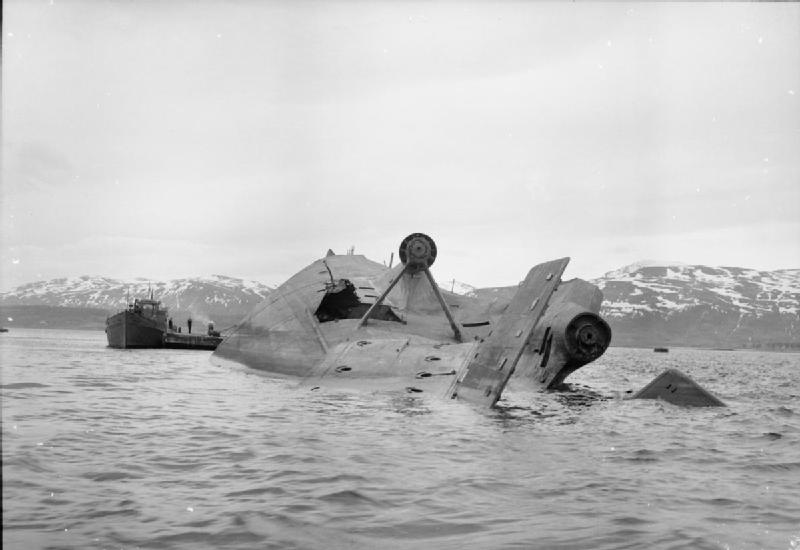
Tirpitz capsized
In retrospect, the German battleships of the Second World War were no more successful than their predecessors in the High Seas Fleet had been. While they scored a few tactical victories and tied down a lot of British warships, it's hard to argue that the effort spent on them shouldn't have gone to U-boats or tanks instead. Hitler, despite his criticism of Tirpitz and the High Seas Fleet in Mein Kampf, made the same mistakes when he took power, and for many of the same reasons. As usual, ships built without a good purpose ended up doing very little, even if they did achieve lasting fame.
1 While the Deutschland class Panzerschiffe are sometimes counted as capital ships, modern scholarship treats them as merely overarmed heavy cruisers instead, a convention I will follow. ⇑
2 This always annoys me. While she does have the rare honor of having single-handedly sunk another capital ship, she was otherwise ineffective, and didn't even finish her maiden voyage. For some reason, this seems to attract interest. See the Titan 1C for another example. ⇑
3 The Germans had some rather odd naming conventions. Unlike the sensible nations, they would order ships under an interim name, and the final name was not revealed until launch. Ships that were being built as replacements for other ships were named Ersatz (name of ship being replaced), while new ships that expanded the fleet were given a letter designation. ⇑
4 There are persistent rumors of a 700,000 ton H45 design armed with 80 cm guns. These have no basis in reality, and are the result of internet sketch designs. Author David Porter took them seriously, which meant that the H class Wikipedia article included the H45 for some time. ⇑
5 Note the straight stem. The ships were found to be wet forward, and a flared "Atlantic" bow was added. Also, I'm not sure if this was taken before she received her fire-control equipment, or if it was airbrushed out. ⇑
6 It's a little-known fact that the Allies didn't really lose the battle for northern Norway. With the defeat in France and Italy joining the war, they no longer had the resources to pour into it, and so withdrew. ⇑
7 I'm not really sure why Bismarck was so ineffective in this action. ⇑
8 There's a long-running and deeply stupid debate over what actually sank Bismarck, driven mostly by Wehraboos who seem to think that the ship being scuttled actually matters for some reason. The scuttling charges were indeed set off as part of the standard procedure for abandoning ship, but the fact that Bismarck was destroyed is entirely the responsibility of the British. ⇑
9 Today, safety regulations prohibit carrying ammo into drydock, but it was apparently common practice before and during WWII. ⇑
10 This may not be technically true, as the Germans apparently used her main guns as AA guns. That said, battleship guns are meant for surface targets, and trying to shoot down planes with them is just unnatural, and doesn't count. ⇑
11 All of the repairs were carried out in the Norwegian fjords, in some of the great epics of WWII naval engineering. ⇑

Comments
Only three classes, the US had ten classes of battleship in WWII (assuming I'm counting correctly) and even the British had four classes that they called battleships (along with one fast battleship they called a battlecruiser) and Japan had five classes (one of which were originally battlecruisers before being redesignated fast battleships and the other were converted into aircraft carriers (or at least something vaguely like an aircraft carrier) late in the war).
Nothing about the sinking of Glorious was luck. B-Dienst had broken British naval codes, and knew exactly where Glorious was and the fact that she had no proper escort. The twins were dispatched to sink her.
@Tuna
It's quite possible you're right. I wrote this over a long stretch, and often based on wiki. When I get home, I'll take another look at the matter.
I've looked into this more, and can't find any evidence that there was a B-Dienst break that lead to the sinking of Glorious. This very detailed account only mentions B-Dienst picking up a message during the battle itself. The British were rather paranoid about radio silence, so it's not implausible they weren't putting out enough signals for the Germans to pick up.
@Anonymous: Other navies had more classes of ships, true, but the difference between classes was generally less stark than the KM's "pre-Dread - sub-Treaty - post-Treaty" variety. In the USN for example, the meaningful distinction was not between the various classes but rather between all of the "old" (Standard) types and all of the "modern" (Treaty and post-Treaty) types.
I was under the impression that while radio intercepts were used to know where the Bismark was headed, it was a US Navy officer in a PBY Catalina flying boat on loan to the British that actually established Bismark's position enough for the British to launch a carrier air strike.
Haha, don't let them hear you say that over at the NavWeaps discussion boards. I'm no Bismarck expert, but the weight of opinion among the more credible-seeming posters there (the ones who squeeze posts with actual information in between the frothing ad-hominem salvos) is that the quoted statements aren't so much flatly false as very misleading. For instance, they would say that the Germans very consciously chose that armor scheme because they judged it superior for the close-range combat they thought was more likely in the rough/rainy North Atlantic, while the US went with our more All-or-Nothing style scheme because we intended to fight at much longer ranges thanks to the better visibility conditions common in the Pacific. Someone also provided a screenshot from a USN evaluation of Bismarck that specifically called out her "excellent scheme of protection" or words to that effect as a design feature of note.
I think I'll wait for my copy of Garzke's new book to decide, since he said he's going into the nitty-gritty of the design process in the early chapters.
re: the 'main guns as AA' thing, I can see pretty well that this was almost pointless, but how hopelessly unlikely was it to accomplish anything?
Would it stand a fair chance of at least subjecting the targeted plane to a loud boom that would stand out over the other sounds of battle? If it could achieve that, you could at least tell yourself it might be having a psychological effect...
Slightly off-topic perhaps, but I'm curious what the general consensus of informed opinion is on the German surface ships as commerce raider strategy in WWII, and what was driving their thinking on the subject at the time.
It seemed like WWI would have demonstrated that U-boats could be quite effective when you let them off the leash (aside from diplomatic consequences), but that the Germans were not really capable of maintaining powerful surface warships outside of their home ports (Battle of the Falklands). But then in WWII they seemingly double-down on the surface raider strategy even when they were facing an even more overwhelming disadvantage against the RN's global presence. And that's not even mentioning the improved capacity of airplanes to track/attack surface raiders.
The pocket battleships I can somewhat understand as being appealing at first glance (we'll just sink any cruiser/destroyer we encounter) but I would have thought a surface raider probably wants to avoid running into any enemy ships rather than try to engage in naval battles (how are you going to repair damage and resupply ammunition?). Graf Spee ends up being scuttled after running into one not-hugely-impressive cruiser squadron, although I've seen some blame that on incompetence and cowardice by the captain, which seems a bit harsh.
Given that, going even bigger and trying to use a battlecruiser/battleship for commerce raiding just seems insane. So am I being uncharitable to the Germans? Could the surface raiders have been more effective given better luck/more intelligent orders? Maybe with a bunch of light cruisers, topping out at the pocket battleships, rather than the bigger ships? Or was the whole strategy actually absurd from the start, and should have been seen as such at the time given the WWI experience?
@Civilis
I believe that is true. This is the problem I run into if I do a summary post. At some point, I'll do a full account of the Bismarck chase, but this wasn't that post.
@Directrix Gazer
This post is pretty high-level, and not a very careful design analysis of the Bismarck class. I'm aware of the theoretical logic behind the choice, but I've also heard suggestions that it was more due to a lack of design clarity that they copied the old arrangement. I'll soften the language a bit for now.
And like you, I'm eagerly awaiting that book, although I won't order until the free shipping window opens.
You're faced with all the normal problems of AA action, namely that you're trying to hit a maneuvering target with a significant time lag in the system, and also the problem that the guns aren't set up for that. Any time fuse has to be set manually before the shell goes in, and the gun has to be aimed more or less by eye. You're probably just as likely to do damage with a given shell from a 105mm, and those pump out a lot more shells. The incendiary shrapnel shells on the Yamatos may have been pretty much useless, but at least they looked cool. These don't even have that advantage.
@Gareth
I think the piece you're missing is that a lot of the German fleet plan was built around a war with France, not the UK. I know that sounds bizarre, but Hitler spent a long time trying to avoid war with England (which proves he wasn't totally stupid, at least in the early years.) The Panzerschiffe were designed for commerce raiding, and every step up after that was a raise in a naval race with the French. The full Plan Z would have challenged Britain, but it never got anywhere, and Raeder was forced to fight with the navy he had.
@gareth
The only possible advantage is that it requires more dedicated anti surface units to tie them down? At the extreme, you can imagine a German Navy with just U-boats and a small local fleet of mine layers, torpedo boats, and so on. While advantageous in terms of sinkage inflicted per ton built, it would also have made the job a lot easier for the Allies, because then you don't have to worry about significant surface threats at all. I'm not sure how it would work out in the end, but I'm suspicious an all or nothing strategy of U-boats would have some flaw.
Just a theory, but maybe it’s something to do with Royal Navy politics. If the battleships didn’t have an impressive foe, then all the glory would go to the destroyers. It may have been worth building battleships just to intimidate the Germans into not building a surface force (and to not attempting Sealion), but that’s not the sort of story that sells newspapers, nor does it boost the naval budget. The heroic efforts of our men, faced with overwhelming opposition but still coming out on top - that’s a story that can get you more funding.
Plus possibly some non-naval politics: May 1941 was a pretty grim time for the British in general. Germany had overrun or allied with most of Europe, the Brits were just about the only remaining undefeated foe. Germany appeared to be still allied with the USSR, and the US wasn’t doing much. Bismarck was just about the only victory they could celebrate, and so I’m sure it made plenty of propaganda fodder. Again here, it’s a better story if Bismarck is more impressive, while spreading around the credit to the whole Royal Navy doesn’t call out any particular ship as her equal.
@Bean That would certainly explain my confusion, and I guess then if you're stuck with all these expensive surface ships against a vastly superior fleet you didn't intend to fight then you might as well go to commerce raiding to try to recoup some of the investment. The wisdom of thinking you could fight a naval war against France without getting the British involved is beyond my pay grade, but certainly seems optimistic, to say the least.
@RedRover Playing off the above a bit, the concept of a dedicated semi-fleet in being just to tie down the some of the British surface units does seem sensible. Tirpitz' career kind of shows the potential efficacy of that strategy. I am admittedly not sure what the British would have done instead with all the ships occupied to defend convoys against potential surface attacks that would have been so bad for Germany. Sending them to the Pacific (as in A Blunted Sickle) is a wash for the Germans, and I'm not sure that the existing German ships were really deterring the RN from shelling the German coast if they wanted to (presumably the Germans had other defensive measures in place). Maybe the added ships would have gone to the Med to fight the Italians, or helped protect Atlantic convoys from U-Boats (although the heavier ships aren't much use there).
What I don't really understand is committing to the fleet-in-being approach and then sending your most expensive ships on extremely risky surface raiding expeditions, most of which were pretty unimpactful (which the Germans recognized and gave up on pretty soon). It seems like the aggressive surface raiding strategy was the default, and then abandoned for the distraction/tie down British ships plan once it proved ineffective.
Missed this the first time around. I'd be suspicious unless I knew the context of this evaluation in more detail. For instance (based on a real example I suspect you will recognize) a major enemy vessel is captured after the war. The naval constructors and three line officers are asked to look it over and write reports. The constructors find a few minor interesting features which they may adopt, but view the general design philosophy as inferior to their existing one, and say so in great detail in their report. Two of the line officers write fairly bland reports. A good feature or two, but nothing spectacular. The third writes a report claiming that the other side's philosophy is vastly superior, and should be adopted wholesale. The author is quickly shunted somewhere he can't do any harm. Decades later, someone looking to prove a point stumbles across his report, and posts it on NavWeps.
@David W
The British and the surface RN playing it up at the time makes sense. What I'm confused about is why everyone is still under their influence today. I ran across a list of ships with the most mentions in libraries, and Bismarck was the only modern warship on the list. I was very irritated by that.
@Bean
It was the conclusion section from a US Navy Technical Mission to Europe (USNTME) report on the ship. For the reasons you state I don't put all that much weight on it.
One thing to keep in mind about German commerce raiding was that it happened in the middle of a sensor revolution -- the Germans weren't expecting to be so consistently tracked by the British as radar-equipped cruisers made possible. Raiders with the ability to vanish in the trackless depths of the ocean are pretty neat; raiders with radio-emitting barnacles attached to their track are much, much easier to corner with superior force.
The Naval Technical Missions are a pretty reliable source, but the European reports are a lot harder to find than those of NTMJ. I’d like to see the full report, and probably some commentary before I drew conclusions from it. I’ll look into this more if/when I do a more detailed discussion of Bismarck.
@Tony
I suspect that the bigger change was the introduction of air-to-surface radar and better airplanes. This made it possible for aircraft to reliably search large areas of sea very quickly and reasonably reliably.
The existence of surface raiding fleets might have made the sub-hunting job harder for the Allies.
At least when I'm playing Germany in HOI3, the British AI tends to hunt for my subs by scattering small units of destroyers to look for them. If all I have is subs, then that does a really good job. But if I also have a respectable force of surface ships, I can send my whole fleet out periodically to pick off a few of the destroyer squadrons and run back to port before the Brits can get their main fleet out to fight me.
Despite HOI3's obvious shortcomings as a historical simulator, I think there's probably some resemblance to real life here. Wikipedia's article on the Battle of the Atlantic, at least, has a reference to the Allies assigning older battleships to convoy escort duty in order to counter German surface raiders. If the threat of surface raiders forced the Allies to reinforce their convoy escorts and other anti-raider fleets with large surface warships, then that's a significant diversion of resources from sub-hunting (since the Allies need to build and operate more BBs to have enough to go around), and sending out BBs as convoy escorts seems like it would also create opportunities for subs to sink BBs (I don't think they actually got any BBs on escort duty, although they did get one during a torpedo raid against an anchored fleet and another by ambushing a British surface raiding fleet).
ADifferentAnonymous:
It'd have quite a sonic boom, though whether a near miss would be clearly audible over a load engine and propeller is another matter.
David W:
Bismarck also destroyed the pride of the Royal Navy very quickly.
Gareth:
Any war against France would get the British involved in some way as British grand strategy was based around preventing anyone one power from taking the geographical region called Europe of the Eurasian continent.
Gareth:
They might not have built Vanguard, sure the thing wasn't completed until after the war but the resources could've likely built some destroyers that would be completed before the end, possibly also transferring some cruiser production to destroyers.
Fun fact: The Germans did build an aircraft carrier, but never finished it. Wouldn't have done them any good, I guess.
@Robin
Graf Zeppelin is an interesting case. The Germans really didn't get carrier aviation. My favorite anecdote is that they decided to correct the flaw in everyone else's carrier plans, and make the hull symmetrical. Then, they discovered why the other nations had asymmetrical hulls, when the ship had a permanent list because of the island, and had to add a blister to compensate.
As for utility, the problem they had was that the planes they'd modified for carrier use were obsolete. Also, they were modified, and not very well.
"The effort was less than a total success, as the two ships sank only 22 merchantmen over the course of the 60-day cruise"
Sinking 22 ships with 2 ships in only 2 months, while hampered by an order to run away from anything resembling a capital ship, is a failure?!?!
Regarding Bismarck's protection scheme, it kept the ship afloat until well after Bismarck was mission killed... so wasn't it "good enough" from a practical perspective?
For the amount of effort involved, absolutely. If you have battleships going after the convoys, you should be able to do better than knocking over an occasional underdefended convoy, the sort of thing a Panzerschiffe or heavy cruiser could take. During Jan-Mar 1941, submarines sank 566,585 tons of ships, aircraft 281,216 tons, and raiders 308,798 tons. I don't know what fraction of that was the battleships, but I suspect based on average merchant ship size that it was about half. Unfortunately, Morison only gives statistics from January of 42, so I can't say how many U-boats were deployed at the time, but it wasn't a large number.
A lot of that, IIRC, was the British choice to engage at close range, which played to the system's strengths.
From extremely hazy memory, wasn't the proposed mechanism for shooting down aircraft with the main battery that the shells would generate splashes high enough to hit a Swordfish on a torpedo run? Not that that seems any more likely to work, but I thought that was the idea.
"I honestly cannot understand this. While she does have the rare honor of having single-handedly sunk another capital ship, she was otherwise ineffective, and didn’t even finish her maiden voyage. For some reason, this seems to attract interest. See the Titanic for another example."
If you honestly cannot understand how romance and tragedy are more generative of lasting fame than excellence in design or operational success, I don't know what to tell you. The Bismarck chase is practically Achilles/Hector, and that yarn's popularity has proved quite lasting.
"I’m not really sure why Bismarck was so ineffective in this action."
I've always assumed this stemmed either directly or indirectly (through morale effects on the crew) from the inability to manoeuvre stemming from the jammed rudder.
That was indeed a mechanism used to attack airplanes with main guns, but it wasn't used in this case. Because Tirpitz was in a fjord, torpedo attack wasn't possible. They had to come in at altitude, which meant that the guns would have to be time-fused.
I guess. Some of it is probably the fact that I think it's overdone. There are a lot of great stories from the war at sea, and everyone focuses on about three.
Man, what I wouldn't give for a well-made film about any of the naval engagements around Guadalcanal.
A couple thoughts on the Bismarck’s armor scheme, for what they’re worth.
Going over the positives, the combination of the armored belt and sloped deck (up to 68 degrees from vertical) made it fantastically difficult to get a shell through to the vitals. The upper belt and the armored weather deck would also make it difficult to reach the main armored deck without a relatively long fuse delay. The distribution of the main armament in four twin turrets makes some sense as well from a survivability standpoint, as it was unlikely for a single hit to knock out a major fraction of the ship’s firepower.
All that said, the placement of the main armored deck just above w.l. would seem to introduce new issues. Obviously that cut the protected volume a bit (offset at least in part by the length of the citadel). More problematic, at least IMHO, was that the system would allow any bomb capable of cutting through the weather deck the opportunity to go off deep in the ship. Given all the sensitive bits (machinery, magazines) directly below the main armored deck, it seems like large (1000lbs+) SAP bombs could be very effective. Just the shock effect from several hundred pounds of explosives wouldn’t do the ship any favors, never mind if the MAD gets holed by the blast (from what I’ve read, one of the Twins had their MAD holed by the blast of a lowly 500 pounder).
I haven't spent a lot of time thinking about Bismarck since I wrote this, as other topics have called, so I'm having to dig a fair number of facts out of mental storage. I'm definitely more sympathetic to the argument on the twin turrets since I started playing Rule the Waves. But I just can't get past the completely inadequate deck armor. Tirpitz took a lot of air attacks, and looking through a list of hits from the 3 April 1944 attack in D&G, I'm not particularly impressed. At least one 500-pounder drove fragments through the main armored deck. This is a battleship, not a destroyer, and that shouldn't be happening. Another ~1500 lb bomb penetrated the armored deck in August, but failed to go off. The big problem was just that she was in a fjord with lots of AA guns around, which made air attacks really hard.
Certainly for the amount of steel devoted to horizontal protection, the results seem more than a tad subpar.
Flaws aside though, Bismarck’s story is one of those just made for the silver screen. Pride of the British fleet sunk! German battleship eludes shadowing British forces! The Germans slip up with a radio message! A last ditch air attack in horrid weather scores a one in a million hit, disabling the enemy! A final duel to the bitter end! What more do you want : )
I want Bismarck to not get a completely disproportionate amount of attention relative to everything else going on at sea. That's why I don't talk about it much.
More seriously, I'd be delighted if they decided to remake Sink the Bismarck today. I'll take all the chances at a good naval movie I can get, particularly when they aren't made by idiots who are better suited to movies with lots of aliens in them. This is one of the reasons I'm so mad at Greyhound getting picked off by Apple. If it had done well at the box office, we might have gotten more. But I really wish it wasn't so easy to find books about Bismarck, and so (relatively) hard to find books about everything else.
...I'd love to see Tora Tora Tora or Battle of Britain done with modern CGI - they'd never get me out of the theater.
If directors "who are better suited to movies with lots of aliens in them" want to make movies about WWII battleships...
https://en.wikipedia.org/wiki/SpaceBattleshipYamato
There was talk of a remake of 'The Dam Busters' a while ago. There really should be enough good stories that you don't need to remake an old one though. I keep hearing suggestions that the battle a Castle Itter would make a good film (and would probably not require much CGI) though there are many other possibilities.